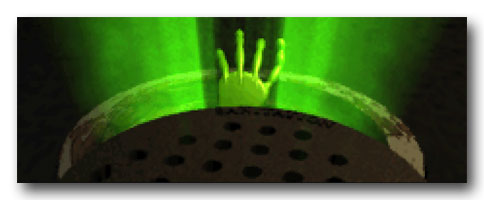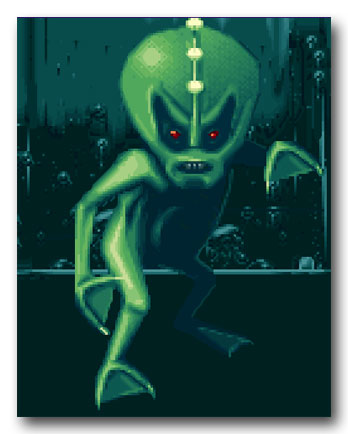
When gamers say they want more X-COM, they should specifically state they want more of UFO: Enemy Unknown, the terrific first game of the series. What they do not want is X-COM: Terror from the Deep, a textbook example of how not to go about making a sequel. While the game is technically “more X-COM,” it’s more in all the wrong ways.
Notably, the original designers, Julian and Nick Gollop, had no involvement with TFTD. They wisely declined Microprose’s request for a quick and dirty follow-up to UFO: Enemy Unknown and chose instead to work on a more ambitious sequel. Rebuffed but undaunted, the publisher licensed the game engine and quickly pumped out TFTD in 1995.
That Microprose needed the money seems indisputable. The company lost 8 million dollars after an ill-advised foray into arcade gaming with F-15 Strike Eagle (1990) and B.O.T.S.S.: Battle of the Solar System (1992) and, deep in debt, had been sold to Spectrum Holobyte in 1993. By 1995, Spectrum Holobyte, itself in the red after the Microprose purchase, would have been desperate to see some return on its investment and there was no easier and faster way of going about this than fulfilling gamer demand for more of Microprose’s 1994 hit.
The emphasis with the sequel really was on “more.” There are more mission types. There’s more to the missions. There’s more ground to cover. All this seemed precisely what gamers would have wanted from a sequel.
But more isn’t always better especially when you fail to grasp why the original worked. It’s worth remembering Microprose’s new owners didn’t quite get the appeal of UFO: Enemy Unknown during its development and had actually considered cancelling the game on several occasions.
The Unknown
One of the best parts of UFO: Enemy Unknown, the thing that made the first campaign so memorable, was discovering the nature of the alien threat, finding out the hard way what fantastical abilities the individual species possessed and experimenting with tactics to counter them. That first campaign was filled with unforgettable moments — learning the Chrysallid’s terrifying secret, the first horrifying encounter with the creepy Ethereals.

TFTD’s biggest problem is it lacks this thrill of discovery, this sense of stepping into the unknown. This is uninspired fare, being less Enemy Unknown and more Enemy With A Different Haircut. Everything about the sequel is a little too familiar for veterans of the first game. In place of Sectoids, there are Aquatoids. Instead of the first game’s plasma weapons, TFTD has sonic weapons. Instead of psionic control, TFTD has molecular control.
To be fair, TFTD isn’t simply UFO: Enemy Unknown set underwater; the sequel even has changes for the better. For instance, the Heavy Plasma-equivalent in TFTD, the Sonic Cannon, has no auto mode, which means the smaller sonic weapons, which allowed operators to squeeze off more shots, still have utility. The Ethereal counterpart in TFTD, the Tasoth, loses its floating ability to the Chrysallid-equivalent, the Tentaculat, making the Tentaculat more dangerous without diminishing the threat level of the Tasoths. Time units could now be reserved for kneeling to improve accuracy.
But these are minor tweaks. Welcome to be sure but nothing that had any great impact on gameplay.
More, more, more
The irony is when TFTD’s designers did think big, the results were terrible.
TFTD’s second-biggest mistake was expanding the scope of battles by increasing map sizes and making critical missions multi-stage affairs. Moving over a dozen units turn-by-turn over the course of 30-plus turns on large maps with numerous nooks and crannies for aliens to hide in was not an enjoyable experience; making the player do this on two different stages to complete missions was an awful idea. The tension that made the tactical encounters so gripping in the first game frequently turned into tedium in the second as X-COM operatives hunted down that last alien squirrelled away in some distant hiding place.
This is epitomised by the finale, a three-stage mission which was unnecessarily dragged out with aggravating maze-like maps. What should have been an epic climax to a long campaign was instead reduced to a tiresome slog from one stage to the next.

And yet
While TFTD may be a poor X-COM sequel, it is still an X-COM game and gaming has rarely equalled the drama of the series’ fantastic turn-based battles. The gamer expecting a detached, cerebral experience might be completely taken aback by how affecting these strategy games are on an emotional level. The heart pounds as the men and women under your command step tentatively into the unexplored darkness, the nerves fray as another scream rings out and the unexpected appearance of an alien invader is as startling as it ever was.
The game only gets more exciting as the campaign wears on with the player needing to adapt quickly as the advantage swings one way then the other. The introduction of new foes, some with abilities that prove devastating in battle, will require approaches other than getting there fastest with the mostest. Everyone has a plan until their first nighttime encounter with Tasoths.
Retrieved alien tech, once researched and reverse engineered, will lead to the development of new weapons, armour and items that allow new tactics. With a handful of molecular control specialists and an automated heavy weapons platform or two functioning as speedy advanced scouts, X-COM would finally have the satisfaction of doing to the aliens what the aliens had previously been doing with impunity to Earth’s valiant defenders. The umpteenth battle is as engaging as the first thanks to this continuous flow of new elements introduced into the campaign.

TFTD is not a terrible game by any means but it’s not the X-COM sequel gamers were hoping for. It’s certainly “more X-COM” but more doesn’t always add to the experience and in most respects, UFO: Enemy Unknown is the better game.
If perhaps Microprose had taken its time with its follow-up, if Microprose had made a greater effort to distinguish the game from its illustrious predecessor while still remaining faithful to its spirit, TFTD could have been something special. Instead, even 15 years later, TFTD comes across as a cynical, unimaginative attempt to quickly cash in on the success of the original, notable primarily for being a stark warning to those hoping to exploit the beloved brand name.
